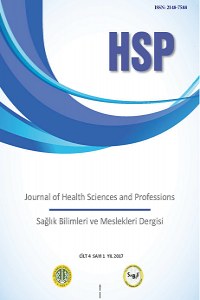İlk ve Acil Yardım Programında Okuyan Öğrencilere Ambulans Simülasyon Laboratuvarında Uygulanan Eğitimin Temel Beceri Düzeyine Etkisi
Abstract
Amaç: Bu
çalışma Sağlık Hizmetleri Meslek Yüksekokulu İlk ve Acil Yardım programında
okuyan öğrenciler üzerinde ambulans simülasyon laboratuvarında uygulanan
eğitimin beceri düzeyine etkisini incelemek amacıyla yapıldı. Gereç ve Yöntem: Yarı deneme modelinde gerçekleştirilen çalışmaya
2013-2014 öğretim yılında Sağlık Hizmetleri Meslek Yüksekokulu İlk ve Acil Yardım
programı birinci sınıfta okuyan 67
öğrenci alındı. Veri toplama aracı olarak, araştırmacılar tarafından
hazırlanan, öğrencilerin tanımlayıcı özelliklerini içeren soru formu ve “Beceri
Değerlendirme Formu” kullanıldı. Öğrencilerin
simülasyon eğitimi öncesi ve sonrasında ambulans içerisinde hastaya müdahale
amaçlı yaptıkları temel tıbbi girişimleri ile ilgili beceri düzeyleri, simülasyon uygulamaları öncesinde ve
sonrasında “Beceri Değerlendirme Formu” üzerinden değerlendirildi. Simülasyon uygulamaları tekrarlayan
aralıklarla üç kez ve öğretim elemanı gözetiminde yapıldı. Bulgular: Çalışmaya katılan öğrencilerin %61.2’si kız, %38.8’i
erkek, yaş ortalaması 18.67±1.18 yıl idi. Öğrencilerin %85.1’i sağlık meslek
lisesi mezunu olduğunu, %40.3’ü bir kurumda çalışmakta olduğunu ve çalışan
öğrencilerin %40.7’si 112’de %14.8’i hastanede acil tıp teknisyeni olarak
çalıştığını belirtti. Öğrencilerin simülasyon öncesi ve sonrası “Soluk yolunu
açma” ve “Kalp masajını uygulama” işlem basamaklarını doğru yapma oranları
karşılaştırıldığında aralarındaki farkın istatistiksel olarak ileri derecede
anlamlı olduğu, simülasyon sonrası işlem basamaklarını daha doğru yaptıkları
bulunmuştur (p<0.001). Sonuç:Öğrencilerin temel yaşam desteği uygulamalarına
yönelik işlem basamaklarının hepsinde doğru yapma oranları simülasyon eğitimi
sonrasında artmıştır. Sonuç olarak simülasyonla eğitimin öğrencilerin beceri
düzeylerini artırdığı söylenebilir.
References
- 1. Mıdık Ö, Kartal M. Simülasyona dayalı tıp eğitimi [Simulation-Based Medical Education]. Marmara Medical Journal 2010;23(3): 389-99.
- 2. Issenberg SB, Mc Gaghie WC, Petrusa ER, Gordan DL, Scalese RJ. Features and uses of high-fidelity medical simulations that lead to effective learning: A BEME systematic review. Medical Teacher 2005;27(1): 1028.
- 3. Gaba DM. The future of simulation in healthcare. Simulation in Healthcare 2007; (2): 126-35.
- 4. Bradley P. The history of simulation in medical education and possible future directions. Medical Education 2006;40(3): 254-62.
- 5. Langrana N, Burdea G, Ladeji J, Dinsmore M. Human Performance Using Virtual Reality Tumor Palpation Simulation. Computers & Graphics 1997;21: 451-458.
- 6. Maran NJ, Glavin RJ. Low-to high–fidelity simulationa continuum of medical education. Medical Education 2003;37(1): 22-8.
- 7. Cant RP, Cooper SJ. Simulation-based learning in nurse education: systematic review. Journal of Advanced Nursing 2009;66(1): 3-15.
- 8. Alinier G. Nursing students' and lecturers' perspectives of objective structured clinical examination incorporating simulation. Nurse Education Today 2003;23(6): 419-26.
- 9. Cioffi J. Clinical simulations: development and validation. Nurse Education Today 2001;21(6): 477-86.
- 10. Moule P, Wilford A, Sales R, Lockyer L. Student experiences and mentor views of the use of simulation for learning. Nurse Education Today 2008;28(7): 790-97.
Abstract
Aim: This study has been performed to
evaluate the effect of the applied-education in the ambulance simulation
laboratory on the skill level of students registered in the Emergency and First
Aid Program of Health Services Vocational School. Material and Methods:
67 students, registered in junior class of the Emergency and First
Aid Program of Health Services Vocational School in 2013-2014 academic
year, were admitted to the study conducted with half experimental model.
Student questionnaires and “Skills Assessment Form" prepared by
researchers which contained descriptive features of students were used as the
data collection tool. Basic skill levels of students, related to the
intervention for the patient in the ambulance, were evaluated pre and
post-simulation education using the “Skills Assessment Form”. Simulation
applications were performed under the supervision of the instructor with
repeated intervals. Results: Female percentage were 61.2%, male percentage were 38.8%
and the mean age were about 18.67 ± 1.18 for the students participated in the study. 85.1% of the students were the
health vocational high school graduates, percentage of the working students and
employees in an institution were 40.3%. 40.7% of working students were employed
in 112 and 14.8% were employed as emergency medical technician in a hospital.
When pre and post-education performances of students in "opening the pale
road" and "Heart massage application" were compared it was found
that the difference was statistically significant (p<0.001) and they
performed the operation steps more accurately after the education. Conclusion: Accuracy of performing the basic life
support applications of students were improved in all steps following the
simulation education. As a result, it can be concluded that skill levels of
students have been increased due to the education with simulation.
References
- 1. Mıdık Ö, Kartal M. Simülasyona dayalı tıp eğitimi [Simulation-Based Medical Education]. Marmara Medical Journal 2010;23(3): 389-99.
- 2. Issenberg SB, Mc Gaghie WC, Petrusa ER, Gordan DL, Scalese RJ. Features and uses of high-fidelity medical simulations that lead to effective learning: A BEME systematic review. Medical Teacher 2005;27(1): 1028.
- 3. Gaba DM. The future of simulation in healthcare. Simulation in Healthcare 2007; (2): 126-35.
- 4. Bradley P. The history of simulation in medical education and possible future directions. Medical Education 2006;40(3): 254-62.
- 5. Langrana N, Burdea G, Ladeji J, Dinsmore M. Human Performance Using Virtual Reality Tumor Palpation Simulation. Computers & Graphics 1997;21: 451-458.
- 6. Maran NJ, Glavin RJ. Low-to high–fidelity simulationa continuum of medical education. Medical Education 2003;37(1): 22-8.
- 7. Cant RP, Cooper SJ. Simulation-based learning in nurse education: systematic review. Journal of Advanced Nursing 2009;66(1): 3-15.
- 8. Alinier G. Nursing students' and lecturers' perspectives of objective structured clinical examination incorporating simulation. Nurse Education Today 2003;23(6): 419-26.
- 9. Cioffi J. Clinical simulations: development and validation. Nurse Education Today 2001;21(6): 477-86.
- 10. Moule P, Wilford A, Sales R, Lockyer L. Student experiences and mentor views of the use of simulation for learning. Nurse Education Today 2008;28(7): 790-97.
Details
| Subjects | Health Care Administration |
|---|---|
| Journal Section | RESEARCH ARTICLE |
| Authors | |
| Publication Date | February 9, 2017 |
| Published in Issue | Year 2017 Volume: 4 Issue: 1 |


